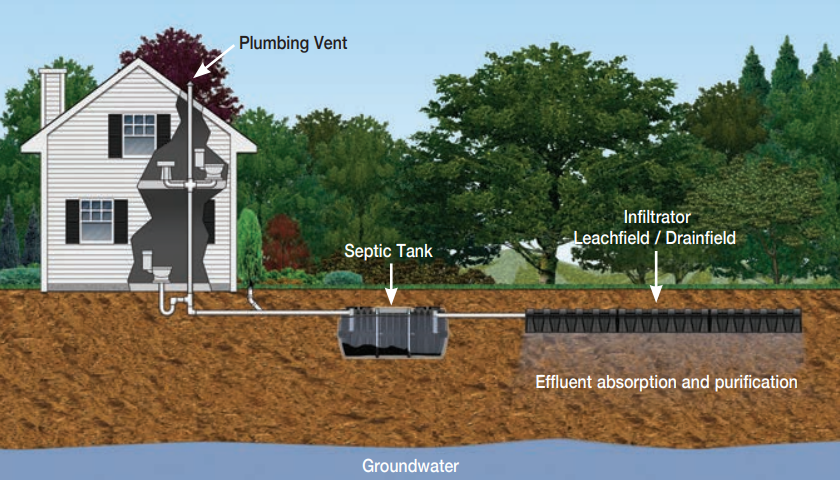Septic System Basics
Wherever you live, you have one of two kinds of wastewater systems: You may be connected to a town or city sewer network with a centralized water treatment plant, or you could have your own onsite septic system. If you’re in the latter group, this page will introduce you to the septic system basics – how they work, how to maintain them, and why they are a safe, reliable choice.
What is a Septic System?
 A septic system is an onsite wastewater treatment system that processes and purifies household waste (effluent). The effluent consists of blackwater (toilet wastes) and graywater (kitchen sink, bathtub and laundry wastes).
A septic system is an onsite wastewater treatment system that processes and purifies household waste (effluent). The effluent consists of blackwater (toilet wastes) and graywater (kitchen sink, bathtub and laundry wastes).
A septic system has two components: a septic tank and a leachfield or drainfield (soil absorption field). Primary treatment occurs in the septic tank, where bacteria digest organic materials in the wastewater. The effluent then flows into the leachfield for secondary treatment. Here, bacteria complete the digestion and purification process as the wastewater slowly leaches or infiltrates into the soil.
Onsite systems for recycling wastewater have become a sustainable long-term solution in places where community public sewer systems are not physically or financially viable. Onsite systems make efficient use of space as land development puts new pressures on natural resources.
Download Our Homeowner’s Septic System Manual ›
Maintaining a Healthy Septic System
Protect your family's health and the environment with proper wastewater management. Regular maintenance and appropriate care can help you avoid a septic system disaster.
Download Our Healthy Septic System Tips ›
Winter Maintenance of Your Septic System
There’s never a good time for a septic system problem—but maintenance is especially important during the cold winter months. These tips can help keep your septic system in top working order.
Download Our Winter Maintenance Tips ›
Public Health and Safety
When it comes to onsite wastewater recycling, protecting public health and the environment are the main priorities. Dangerous bacteria, microbes and pathogens must be completely removed from wastewater before it re-enters the groundwater. Infiltrator products are scientifically designed to provide more efficient wastewater treatment by optimizing the soil’s inherent treatment capabilities.
Onsite systems provide a passive, reliable means of wastewater treatment at a relatively low cost, while preserving environmental quality. As the population density increases, regulators and public health officials responsible for water quality have emphasized the need for regulations based on sound science and real performance.
Infiltrator sponsors and participates in a variety of programs, including field training, continuing education for installers, and curriculum support for onsite system design studies. The experts on our technical staff, along with our regional representatives, exchange information and seek solutions that promote better science, improved system performance and groundwater quality.
